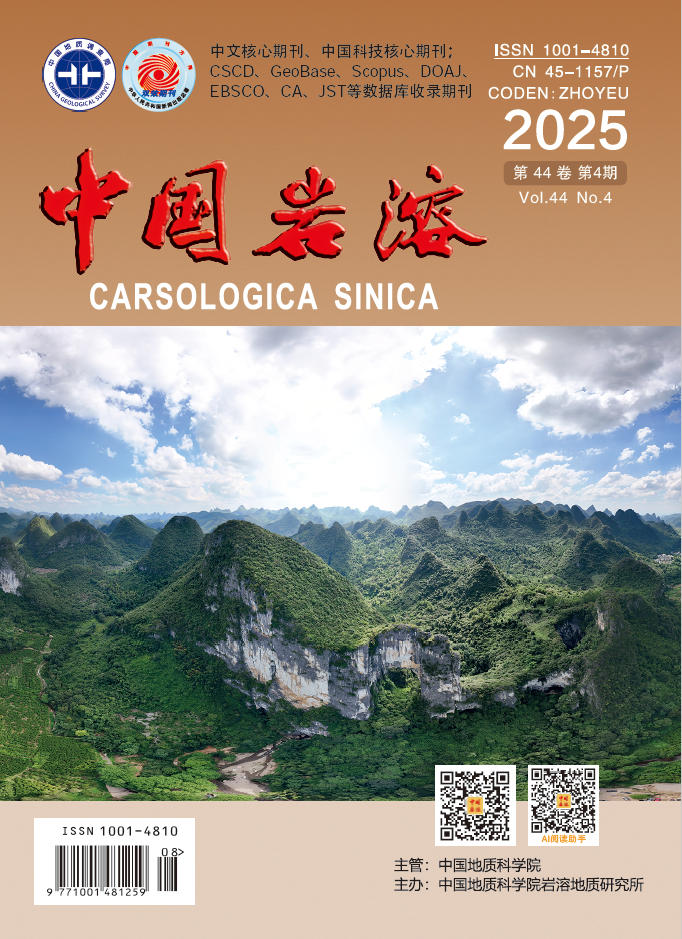2024, 43(5): 1144-1155.
doi: 10.11932/karst20240511
Abstract:
In recent years, the increasing intensity of human engineering activities—such as groundwater extraction, drainage for underground engineering, mine drainage, blasting, pile foundation construction and drilling engineering—has led to karst ground collapses. This phenomenon has become an important issue hindering the economic and social development of karst areas. If construction processes in these karst areas are not disposed properly, the punching pile construction commonly used in foundation construction can often cause severe ground collapse disasters. This article examines the karst ground collapse event triggered by the construction of punching piles in Fuwan, Foshan. Through field investigations and measurements, geological conditions contributing to the karst ground collapse were analyzed with drilling and geophysical exploration. A total of 37 boreholes were drilled in the vicinity the collapse, reaching a distance of 1,950 m. In around six of these boreholes (ZK6, ZK13, ZK15, ZK22, ZK18, and ZK31), a comprehensive exploration method was adopted to conduct three-dimensional infinite full-space exploration. This method utilized boreholes for deep underground exploration and high-precision detection of karst geological development within a 40-meter radiu. A total of 46 omnidirectional detection lines were laid out, covering a length of 2,990 m.Research has shown that the karst ground collapse group on Anhua road in Fuwan is primarily attributed to five factors: (1) The bedrock in this area is composed of high-purity gravel limestone, which is characterized by dense geological structures and numerous karst caves, creating conditions that are conducive to karst ground collapses. (2) The widely distributed muddy sand layers and residual soil layers at the bottom of the Quaternary system provide a favorable material foundation for the development of soil caves. (3) The sand layer is extentively distributed and exhibits a large thickness. Groundwater rescources are abundant and the hydrogeological conditions are complex. (4) The groundwater level is shallow and exhibits a strong hydraulic connection with the surface water. This area is located in a groundwater runoff channel, adjacent to the Xijiang river, and experiences frequent groundwater activities. (5) From the end of 2010 to January 2011, ground collapses occurred due to the vibration generated by punching pile construction.In addition, the formation of karst ground collapse group on Anhua road in Fuwan can be summarized in five stages: the fissure period, the karst cave period, the soil cave period, the collapse period, and the group collapse period. In the early stage, fissures formed in the bedrock as a result of tectonic action. Subsequently, under the combined influence of factors such as crustal uplift, meteorology, hydrology, structure, and marine transgression and regression, the small joint fissures in the bedrock were gradually eroded and expanded, leading to the formation of karst caves. These karst caves were then gradually developed toward the bedrock surface until the bedrock roof became exposed. This marked the beginning of the development period of soil cave. With the changing seasons and the dynamics of marine transgression and regression, groundwater levels fluctuated. The rise and fall of the groundwater erosion baseline were constantly circulating. When groundwater levels rose, soil that has remained dry for an extended time gradually softened, forming a soft layer. Conversely, as groundwater levels declined, soil lost its buoyancy due to the absence of water, resulting in a sharp increase in hydraulic gradient and an intensified erosive effect of pore water. Under the influence of vacuum negative pressure between pores and the erosion caused by groundwater, small particles within the sand layer were continuely displaced and transported to the underlying karst cave characterized by gravel limestone. Therefore, a soil hole was formed between the gravel limestone and the overlying sandy soil layer, and the hole developed and expanded in all directions. During the periods of collapse and group collapse, the construction of punching piles led to repeated fluctuations in the groundwater level. These fluctuations caused groundwater to flow to the surrounding areas through rock, soil and water, which damaged the original structural performance of the surrounding rock and soil, altered the original mechanical equilibrium limit, and triggered additional karst ground collapses in nearby areas.In summary, it is advisable to conduct a specialized karst exploration prior to the construction of punching piles in karst areas to identify the distribution characteristics of karst channels. At the same time, targeted construction plans should be developed. If karst channels are exposed during the construction process, it is essential to enhance the monitoring of karst groundwater to ensure the safety of both the engineering project and personnel involved.






